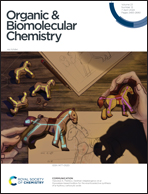DFT study on isothiourea-catalyzed C–C bond activation of cyclobutenone: the role of the catalyst and the origin of stereoselectivity†
Abstract
The organocatalytic C–C bond activation strategy stands out as a new reaction mode for the release of ring strain and expands the scope of organocatalysts. Thus, disclosing the role of the organocatalyst in the C–C bond cleavage process would be of interest. Here, an isothiourea-catalyzed C–C bond activation/cycloaddition reaction of cyclobutenone is selected as a computational model to uncover the role of the catalyst. Based on the calculations, the electrocyclic cleavage of cyclobutenone is calculated to be energetically more favorable than the isothiourea-catalyzed C–C bond cleavage, which is different from the NHC-catalyzed C–C bond activation of cyclobutenone. The computational results show that the isothiourea promotes the reaction by increasing the nucleophilicity of vinyl ketene and thus lowers the energy barrier of the cycloaddition process. Moreover, NCI and AIM analyses are performed to disclose the origin of stereoselectivity.



 Please wait while we load your content...
Please wait while we load your content...